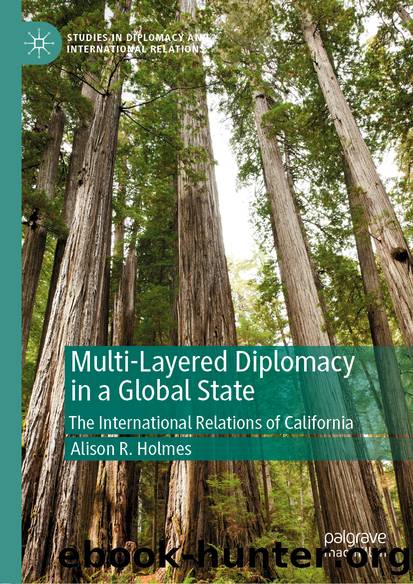Multi-Layered Diplomacy in a Global State by Alison R. Holmes

Author:Alison R. Holmes
Language: eng
Format: epub
ISBN: 9783030541323
Publisher: Springer International Publishing
3.global paradiplomacy, the biggest âreachâ for noncentral governments in that they engage with noncentral, and with central governments in other countries (Duchacek et al. 1988).
These types are closely related, but do not entirely coincide with André Lecoursâs presentation of what he call the three âlayersâ of paradiplomacy and that offer a bridge to what others have called the motivations of subnationals in their paradiplomatic efforts. Lacours includes: (1) economics (issues not explicitly political or cultural); (2) cooperation (the most diverse category including cultural education and technical and technological sharing, but not necessarily for economic gain); and, (3) political considerations (about the affirmation of identity and cultural distinctiveness) (Lecours 2008).
Lacoursâs list closely resembles what Kuznetsov and Keating call the âmotivationsâ of paradiplomacy that they have simplified to: economic, political, and cultural. Kuznetsov does, however, also suggest a fourth motivation that brings the typology full circle. This additional motivation is originally John Kincaidâs category of âcross-border house-keepingâ, or what might otherwise be called regional paradiplomacy (Keating 1999; Kuznetsov 2015).
Keating goes on to make the key point that subnational diplomacy is not the same as constitutional state diplomacy, in that subnational diplomacy is not about ânational interestâ but generally geared to a specific issue or concern. Regions or subnationals are âmore functionally specific and targeted, often opportunistic and experimentalâ¦â. However, the paradiplomacy they practice is ânot functionally determined, and political considerations play the main role in deciding on strategy and initiativeâ (Keating 1999).
Interestingly, much of what was originally understood to be the study of paradiplomacy was focused on secessionist states. Only later, as an increasing number of entities undertook a more collaborative approach or worked in parallel to their central government, was a distinction required between entities seeking to break away from their central authority and those simply seeking to operate on a global scale. The point remains that the term âprotodiplomacyâ was developed to reflect the more narrow and distinctly secessionist motivation of some subnationals undertaking global diplomatic activity (Tavares 2016; Cornago 2010). This is particularly important in the discussion of California as a state given it has, to date, remained steadfastly âsubnationalâ in its paradiplomacy. Yet, as indicated in the Introduction, there is a group interested in the idea of secession for the state (and some for the further break-up of the state into smaller units). Thus far, this idea has not become part of the stateâs mainstream activities.
The idea of protodiplomacy is also important in that it effectively creates a range of activities for the field as a whole. Protodiplomacy becomes one end of the range of options as the approach most incompatible to the âhostâ state goals, while paradiplomacy moves to the center of the field as an increasing number of actors seek to operate on the global stage. In this way, the impact of globalization, namely the compression in levels of governance, has been given a shape by a subfield seeking to understand that activity.
For example, writing from the perspective of State Legislatures, Timothy Conlan and others have
Download
This site does not store any files on its server. We only index and link to content provided by other sites. Please contact the content providers to delete copyright contents if any and email us, we'll remove relevant links or contents immediately.
| Elections & Political Process | Ideologies & Doctrines |
| International & World Politics | Political Science |
| Public Affairs & Policy | Specific Topics |
| United States |
The Secret History by Donna Tartt(16623)
The Social Justice Warrior Handbook by Lisa De Pasquale(11489)
Thirteen Reasons Why by Jay Asher(7788)
This Is How You Lose Her by Junot Diaz(5772)
Weapons of Math Destruction by Cathy O'Neil(5037)
Zero to One by Peter Thiel(4824)
The Myth of the Strong Leader by Archie Brown(4789)
Promise Me, Dad by Joe Biden(4447)
Beartown by Fredrik Backman(4419)
Stone's Rules by Roger Stone(4415)
How Democracies Die by Steven Levitsky & Daniel Ziblatt(4399)
The Fire Next Time by James Baldwin(4343)
100 Deadly Skills by Clint Emerson(4079)
A Higher Loyalty: Truth, Lies, and Leadership by James Comey(4033)
Rise and Kill First by Ronen Bergman(4012)
The David Icke Guide to the Global Conspiracy (and how to end it) by David Icke(3882)
The Farm by Tom Rob Smith(3872)
Secrecy World by Jake Bernstein(3782)
The Doomsday Machine by Daniel Ellsberg(3731)
